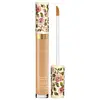What's inside
What's inside
 Key Ingredients
Key Ingredients

 Benefits
Benefits

 Concerns
Concerns

 Ingredients Side-by-side
Ingredients Side-by-side

Cyclopentasiloxane
EmollientWater
Skin ConditioningButylene Glycol
HumectantTalc
AbrasiveTrimethylsiloxysilicate
EmollientCetyl PEG/PPG-10/1 Dimethicone
EmulsifyingCaprylic/Capric Triglyceride
MaskingCetearyl Ethylhexanoate
EmollientAcrylates Crosspolymer
AbsorbentAmmonium Acrylates Copolymer
Dimethicone/Vinyl Dimethicone Crosspolymer
Skin ConditioningDipalmitoyl Hydroxyproline
Skin ConditioningMagnesium Sulfate
Polymethyl Methacrylate
Tribehenin
EmollientDisteardimonium Hectorite
StabilisingLecithin
EmollientLaureth-7
EmulsifyingTriethoxycaprylylsilane
Phenoxyethanol
PreservativeTrihydroxystearin
Skin ConditioningChlorphenesin
AntimicrobialAlcohol Denat.
AntimicrobialPropylene Carbonate
SolventXanthan Gum
EmulsifyingSodium Hyaluronate
HumectantDisodium Deceth-6 Sulfosuccinate
CleansingAcmella Oleracea Extract
Skin ProtectingLaureth-30
CleansingSodium Dehydroacetate
PreservativeRosa Hybrid Flower Extract
Skin ConditioningPentaerythrityl Tetra-Di-T-Butyl Hydroxyhydrocinnamate
AntioxidantCI 77891
Cosmetic ColorantIron Oxides
Cyclopentasiloxane, Water, Butylene Glycol, Talc, Trimethylsiloxysilicate, Cetyl PEG/PPG-10/1 Dimethicone, Caprylic/Capric Triglyceride, Cetearyl Ethylhexanoate, Acrylates Crosspolymer, Ammonium Acrylates Copolymer, Dimethicone/Vinyl Dimethicone Crosspolymer, Dipalmitoyl Hydroxyproline, Magnesium Sulfate, Polymethyl Methacrylate, Tribehenin, Disteardimonium Hectorite, Lecithin, Laureth-7, Triethoxycaprylylsilane, Phenoxyethanol, Trihydroxystearin, Chlorphenesin, Alcohol Denat., Propylene Carbonate, Xanthan Gum, Sodium Hyaluronate, Disodium Deceth-6 Sulfosuccinate, Acmella Oleracea Extract, Laureth-30, Sodium Dehydroacetate, Rosa Hybrid Flower Extract, Pentaerythrityl Tetra-Di-T-Butyl Hydroxyhydrocinnamate, CI 77891, Iron Oxides
Water
Skin ConditioningDimethicone
EmollientHydrogenated Polydecene
EmollientPropanediol
SolventButylene Glycol
HumectantPEG-9 Polydimethylsiloxyethyl Dimethicone
EmulsifyingGlycerin
HumectantDisteardimonium Hectorite
StabilisingPEG-10 Dimethicone
Skin ConditioningPolymethyl Methacrylate
Bis-Butyldimethicone Polyglyceryl-3
CleansingSorbitan Sesquiisostearate
EmulsifyingDimethicone/Vinyl Dimethicone Crosspolymer
Skin ConditioningPhenoxyethanol
PreservativeIsostearic Acid
CleansingPolysilicone-2
Aluminum Hydroxide
EmollientMaltodextrin
AbsorbentTrisodium EDTA
Lecithin
EmollientSilica
AbrasiveTin Oxide
AbrasiveTriethoxycaprylylsilane
Tocopheryl Acetate
AntioxidantSodium Metabisulfite
AntioxidantMagnolia Officinalis Bark Extract
AntimicrobialTocopherol
AntioxidantVitis Vinifera Seed Extract
AntimicrobialMica
Cosmetic ColorantCI 77891
Cosmetic ColorantCI 77491
Cosmetic ColorantCI 77492
Cosmetic ColorantCI 77499
Cosmetic ColorantCI 77163
Cosmetic ColorantCI 42090
Cosmetic ColorantWater, Dimethicone, Hydrogenated Polydecene, Propanediol, Butylene Glycol, PEG-9 Polydimethylsiloxyethyl Dimethicone, Glycerin, Disteardimonium Hectorite, PEG-10 Dimethicone, Polymethyl Methacrylate, Bis-Butyldimethicone Polyglyceryl-3, Sorbitan Sesquiisostearate, Dimethicone/Vinyl Dimethicone Crosspolymer, Phenoxyethanol, Isostearic Acid, Polysilicone-2, Aluminum Hydroxide, Maltodextrin, Trisodium EDTA, Lecithin, Silica, Tin Oxide, Triethoxycaprylylsilane, Tocopheryl Acetate, Sodium Metabisulfite, Magnolia Officinalis Bark Extract, Tocopherol, Vitis Vinifera Seed Extract, Mica, CI 77891, CI 77491, CI 77492, CI 77499, CI 77163, CI 42090
 Reviews
Reviews

Ingredients Explained
These ingredients are found in both products.
Ingredients higher up in an ingredient list are typically present in a larger amount.
Butylene Glycol (or BG) is used within cosmetic products for a few different reasons:
Overall, Butylene Glycol is a safe and well-rounded ingredient that works well with other ingredients.
Though this ingredient works well with most skin types, some people with sensitive skin may experience a reaction such as allergic rashes, closed comedones, or itchiness.
Learn more about Butylene GlycolCi 77891 is a white pigment from Titanium dioxide. It is naturally found in minerals such as rutile and ilmenite.
It's main function is to add a white color to cosmetics. It can also be mixed with other colors to create different shades.
Ci 77891 is commonly found in sunscreens due to its ability to block UV rays.
Learn more about CI 77891This ingredient is a silicone used to improve the texture of products and absorb oil. It does not get absorbed into the skin.
Like other silicones, Dimethicone/Vinyl Dimethicone Crosspolymer helps condition the skin by creating a barrier. In this sense, it can act as an emollient and trap moisture in.
This ingredient is a type of elastomer.
Learn more about Dimethicone/Vinyl Dimethicone CrosspolymerDisteardimonium Hectorite comes from the clay mineral named hectorite. It is used to add thickness to a product.
It can also help stabilize a product by helping to disperse other ingredients.
Hectorite is a rare, white clay mineral.
Learn more about Disteardimonium HectoriteLecithin is a term for a group of substances found in the cell membranes of plants, animals, and humans. They are made up of mixture of phospholipids.
This ingredient has emollient and emulsifying properties.
As an emollient, lecithen helps soften the skin and creates a barrier to keep moisture in.
As an emulsifier, it also helps prevent water and oil ingredients from separating. Lecithin can also help ingredients be better absorbed by the skin.
This is because the phospholipids in lecithin produce liposomes. Liposomes help other ingredients get through the skin barrier.
Depending on the source of this ingredient, lecithin may not be fungal acne safe. This is because some sources of lecithin come from soybean oil, which may feed the malassezia yeast that feeds fungal acne.
We recommend reaching out to the brand you are purchasing from to inquire about the source of their lecithin.
Some other names for this ingredient include soy lecithin and deoiled soy lecithin.
Learn more about LecithinPhenoxyethanol is a preservative that has germicide, antimicrobial, and aromatic properties. Studies show that phenoxyethanol can prevent microbial growth. By itself, it has a scent that is similar to that of a rose.
It's often used in formulations along with Caprylyl Glycol to preserve the shelf life of products.
This ingredient is also known as PMMA. It is a polymer microsphere, composed of tiny, perfectly spherical particles formed from repeating units.
In cosmetics, PMMA is mainly used to give a soft or blurring effect. The transparent particles are able to scatter light and help reduce the appearance of fine-lines and imperfections.
PMMA is also able to enhance the texture of products by add a smooth feel.
Learn more about Polymethyl MethacrylateTriethoxycaprylylsilane is a silicone used to bind and stabilize ingredients.
As an emulsifier, it helps prevent ingredients from separating. This can help elongate the shelf life of products.
Triethoxycaprylylsilane is often used to coat mineral sunscreens ingredients to help give a better feel. It also helps reduce oxidative stress in sunscreens.
Learn more about TriethoxycaprylylsilaneWater. It's the most common cosmetic ingredient of all. You'll usually see it at the top of ingredient lists, meaning that it makes up the largest part of the product.
So why is it so popular? Water most often acts as a solvent - this means that it helps dissolve other ingredients into the formulation.
You'll also recognize water as that liquid we all need to stay alive. If you see this, drink a glass of water. Stay hydrated!
Learn more about Water